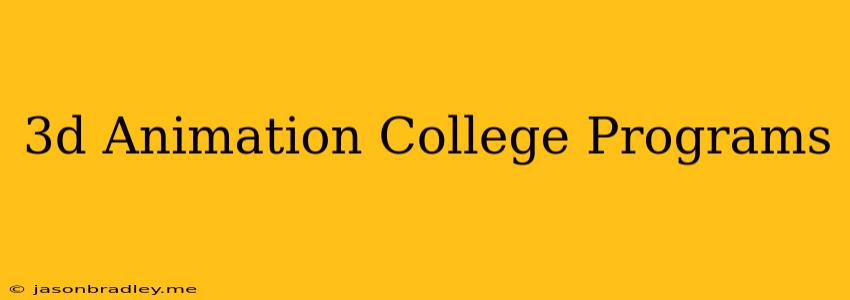3D Animation College Programs: A Guide to Launching Your Career
3D animation is a dynamic and rapidly growing field, offering exciting career opportunities in film, television, video games, advertising, and more. If you're passionate about bringing characters and stories to life, a college program in 3D animation can equip you with the skills and knowledge needed to succeed.
Here's a breakdown of what you can expect from a 3D animation college program and how to choose the right one for you:
What to Expect in a 3D Animation College Program
A typical 3D animation program will cover a broad range of essential topics, including:
- Fundamentals of 3D Modeling: Learn to create 3D objects using software like Maya, 3ds Max, or Blender. You'll master techniques like polygon modeling, sculpting, and surface modeling.
- Animation Principles: Explore the core principles of animation, from timing and spacing to weight and anticipation, to create believable and engaging movement.
- Character Animation: Develop skills in animating characters, from simple gestures to complex facial expressions and full-body movement.
- Rigging and Skinning: Learn how to build and control virtual skeletons and create realistic muscle and skin deformation.
- Lighting and Rendering: Master techniques for creating stunning visuals with light and shadow, and learn how to render 3D scenes for film, games, or other applications.
- Storytelling and Character Design: Understand how to use animation to tell compelling stories and design memorable characters that resonate with audiences.
- Software Proficiency: Gain hands-on experience with industry-standard software, including Maya, 3ds Max, ZBrush, Substance Painter, and more.
Choosing the Right 3D Animation College Program
When selecting a college program, consider the following factors:
- Curriculum: Look for programs that offer a comprehensive curriculum covering all the essential aspects of 3D animation.
- Faculty: Experienced and passionate instructors can make a significant difference in your learning experience.
- Software Access: Ensure that the program provides access to the industry-standard software you'll need to build your portfolio.
- Portfolio Development: A strong portfolio is crucial for showcasing your skills to potential employers. Choose a program that emphasizes portfolio development.
- Industry Connections: Look for programs that offer opportunities for internships, networking events, and guest lectures from industry professionals.
- Accreditation: Choose a program accredited by recognized organizations like the Association of Independent Colleges of Art and Design (AICAD) or the National Association of Schools of Art and Design (NASAD).
Types of 3D Animation Programs
- Bachelor's Degree Programs: These programs offer a comprehensive education in 3D animation, covering all aspects of the field.
- Associate's Degree Programs: These shorter programs provide a strong foundation in 3D animation, focusing on core skills and software proficiency.
- Certificate Programs: These programs offer specialized training in specific aspects of 3D animation, such as character animation or modeling.
Career Paths in 3D Animation
A degree in 3D animation can open doors to various exciting careers, including:
- 3D Animator: Create animated sequences for films, TV shows, video games, and more.
- Character Animator: Focus on animating characters, bringing them to life with realistic movements and expressions.
- 3D Modeler: Create 3D objects, characters, and environments for various projects.
- Visual Effects Artist: Create stunning visual effects for films, TV shows, and games.
- Game Designer: Design and create immersive 3D worlds and characters for video games.
A strong portfolio, dedication to continuous learning, and a passion for storytelling are essential for success in the competitive field of 3D animation. A solid education from a reputable college program can provide you with the foundation needed to launch a rewarding and fulfilling career.
